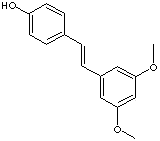PRODUCT IDENTIFICATION
441351-32-2 (cis-)

H.S. CODE
TOXICITY
c1(ccc(cc1)\C=C\c1cc(cc(c1)OC)OC)O
CLASSIFICATION
EXTRA NOTES
PHYSICAL AND CHEMICAL PROPERTIES
off-white crystalline powder
85 - 88 C
AUTOIGNITION
NFPA RATINGS
Health hazard: 2, Fire: 0, Reactivity Hazard: 0
REFRACTIVE INDEX
EXTERNAL LINKS & GENERAL DESCRIPTION
Wikipedia Linking - Pterostilbene
Google Scholar Search - Pterostilbene
Drug Information Portal (U.S. National Library of Medicine) - Pterostilbene
PubChem Compound Summary - Pterostilbene
Drug Bank - Pterostilbene
KEGG (Kyoto Encyclopedia of Genes and Genomes) - Pterostilbene
http://www.ebi.ac.uk/ - Pterostilbene
http://www.ncbi.nlm.nih.gov/ - Pterostilbene
http://toxnet.nlm.nih.gov/
Hazardous
Substances Data Bank - Pterostilbene
Local:
Resveratrol (3,5,4'-trihydroxystilbene) is a
non-flavonoid polyphenolics compound found highly in the skin of red grapes and
as a constituent of red wine. It is also found in teas, berries and peanuts.
Resveratrol is a compound of stilbene structure (and is responsible for the
principle coloring of the plants. Resveratrol is created by plants as a phytoalexin (plant's defense
arsenal) against bacteria
and fungi. It is marketed as a nutritional supplement that shows health-giving antioxidant effects such
as anti-cancer, antiviral, and anti-aging. Resveratrol inhibits COX-1 enzyme and
demonstrates anti-inflammatory effects. It is a platelet aggregation inhibitor
to block the adhesion of blood cells to vessel walls and therefore prevents
heart disease and cerebral apoplexy.
It exists as two structural isomers: cis- (Z)
and trans- (E),
Piceatannol or 3,4,3',5'-tetrahydroxy-trans-stilbene is a phenolic that is structurally related to resveratrol. Piceatannol has one more hydroxyl group at 3' position. It is a metabolite of resveratrol and is found in red wine. Pterostilbene (3,5-Dimethoxy-4'-hydroxy-trans-stilbene) is an analog of resveratrol. The two phenolic hydroxyl groups among three are converted to methyl ethers. Some reports say that the ethers enhance antioxidant effects. Pterostilbene is also know as a Hypoglycemic agent and Apoptosis Inducer. Some examples of Apoptosis Inducer include:
|
Product |
CAS RN. |
|
Tanespimycin |
75747-14-7 |
| 2-Amino-N-quinolin-8-yl-benzenesulfonamide | 16082-64-7 |
|
5-(p-Bromobenzylidine)-α-isopropyl-4-oxo-2-thioxo-3-thiozolidineacetic Acid |
300817-68-9 |
| Borrelidin | 7184-60-3 |
| Brefeldin A | 20350-15-6 |
| Bufalin | 465-21-4 |
| 6-(4-Hydroxy-3-tricyclo(3.3.1.1(3,7))dec-1-ylphenyl)-2-naphthalenecarboxylic acid | 125316-60-1 |
| 1-[4-(Furo[2,3-b]quinolin-4-ylamino)phenyl]ethanone | 479077-76-4 |
| Carboxyatractylate | 35988-42-2 |
| Dimethyloxoxanthene acetic acid | 117570-53-3 |
| Fluticasone propionate | 80474-14-2 |
| Imiquimod | 99011-02-6 |
| Neocarzinostatin | 9014-02-2 |
| Nutlin-3 | 548472-68-0 |
| Pterostilbene | 537-42-8 |
APPEARANCE
off-white to yellowish crystalline powder
98.0% min (HPLC)
LOSS ON DRYING
0.5% max
ASH
0.1% max
HEAVY METALS
20ppm max
MICROBIOLOGICAL TEST
Total Plate Count: 1000CFU/G
max
Mold and Yeast: 100CFU/G max
E.coli: Non-detective
Salmonella: Non-detective
HAZARD OVERVIEW
May be harmful if swallowed. Causes serious eye damage. Toxic to aquatic life with long lasting effects
GHS
PICTOGRAMS


HAZARD STATEMENTS
H318-H411
P STATEMENTS
P273-P280-P305 + P351 + P338
![]()
![]()
RISK PHRASES
41-51/53
SAFETY PHRASES
26-39-61